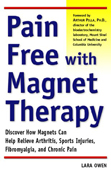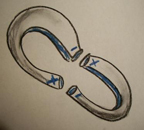Magneet therapie
Magneet en/of magneetveld therapie zijn in opkomst, vooral bij de behandeling van pijn. Magneet therapie is echter ook een vorm van therapie die vaak aangeboden worden als een heel pakket van complementaire behandelvormen in privekliieken. Sommige van die klinieken zijn behoorlijk dubieus en speculeren op de angst van patienten, vooral bij aandoeningen als kankervormen, HIV en AIDS, stress en burnout, multipele sclerosis. Meestal wordt gesuggereerd dat de energie zal toenemen, het leven verlengd zal worden en dat het immuunsysteem gestimuleerd wordt. Bewijs daarvan is afwezig.
 De magneetvelden worden opgewekt door magneten van verschillende grootte en vorm. Ze komen voor als kettingen, armbanden, matrassen, dekens of polsmofjes. De effecten zouden veroorzaakt worden door de invloed van het magneetveld op het veld rond de mens zelf. [1,2] De behandelingsduur varieert van minuten tot weken (bij magnetische matrassen). In de USA heeft de overheid (FDA) producenten van dit soort middelen gestopt om niet bewezen claims te voeren die het gebruik ervan ondersteunen. Er zijn wel experimentele studies in proefdiermodelen en in kweekmedia (in vitro studies) waaruit blijkt dat magneetvelden cellen en zenuwcellen in hun functioneren kunnen beinvloeden. [4,7,14] Ook zijn er wat aanwijzingen dat het onze fysiologie beinvloed, bijvoorbeeld de wondgenezing. [1,3,6,7] Magneetvelden hebben ook invloed op het biologische gedrag van geisoleerde cellen en zunuwcellen. [8,10,13] Ook biologisch actieve moleculen zoals hemoglobine worden door magneetvelden beinvloed. [9] Er is echter geen effect gevonden tegen kanker. Er zijn wat voorlopige effecten gevonden bji aandoeningen zoals fibromyalgie, and artrose. [5,19] Een groot onderzoek naar magneetzooltjes bij patienten met pijn en tintelingen van de voeten door diabetes was positief. [23] Een vergelijkend onderzoek was eveneens positief bij diabetes [12] en ook bij pijn bij polio en voetpijn reageerde positief. [21,22] Een magneet op een
De magneetvelden worden opgewekt door magneten van verschillende grootte en vorm. Ze komen voor als kettingen, armbanden, matrassen, dekens of polsmofjes. De effecten zouden veroorzaakt worden door de invloed van het magneetveld op het veld rond de mens zelf. [1,2] De behandelingsduur varieert van minuten tot weken (bij magnetische matrassen). In de USA heeft de overheid (FDA) producenten van dit soort middelen gestopt om niet bewezen claims te voeren die het gebruik ervan ondersteunen. Er zijn wel experimentele studies in proefdiermodelen en in kweekmedia (in vitro studies) waaruit blijkt dat magneetvelden cellen en zenuwcellen in hun functioneren kunnen beinvloeden. [4,7,14] Ook zijn er wat aanwijzingen dat het onze fysiologie beinvloed, bijvoorbeeld de wondgenezing. [1,3,6,7] Magneetvelden hebben ook invloed op het biologische gedrag van geisoleerde cellen en zunuwcellen. [8,10,13] Ook biologisch actieve moleculen zoals hemoglobine worden door magneetvelden beinvloed. [9] Er is echter geen effect gevonden tegen kanker. Er zijn wat voorlopige effecten gevonden bji aandoeningen zoals fibromyalgie, and artrose. [5,19] Een groot onderzoek naar magneetzooltjes bij patienten met pijn en tintelingen van de voeten door diabetes was positief. [23] Een vergelijkend onderzoek was eveneens positief bij diabetes [12] en ook bij pijn bij polio en voetpijn reageerde positief. [21,22] Een magneet op een 
Er zijn natuurlijk allerlei verschillende vormen en maten en soorten avn toepassingen. Een meer specialistsiche vorm van magneettherapie is de transcraniele vorm, waarbij magneetvelden aangelegd worden door het hoofd heen met relatief sterke magneten. De hoop was dat deze behandeling bij depressie zinvol zou kunnen zijn.Een recente meta-analyse liet echter zien dat de effectiviteit van deze transcraniele magneetvelden niet hoog is.
Patienten met pacemakers of zwangere vrouwen moeten magneet therapie niet ondergaan.
Beoordeling
Magneet therapie zou een nieuwe vorm van behandelen kunnen zijn voor verschillende vormen van pijn. Magneetzooltjes lijken zinvol bij neuropatische pijnen aan de voeten ten gevolge van diabetes. Een zinvol effect bij ernstige aandoeningen zoals AIDS en kanker is bij de mens vooralsnog niet aangetoond. Magneet therapie voor die indicaties is duidelijk nog experimenteel. Maar er zijn tekenen dat elementen uit de magneet therapie misschien binnen de reguliere geneeskunde, bijvoorbeeld de revalidatie geneeskunde, een plaats zouden kunnen krijgen. [15] Magneet therapie lijkt wel veilig te zijn. Vandaar een oranje stoplicht. Een meta-analyse uit 2007 brengt alle wat hier staat in een iets negatiever daglicht nog. Zie elders op de website naar de meta-analyse van Ernst.
Sites
Magneten voor misselijkheid en braken
Literatuur
[1] Hong CZ, et al. Magnetic necklace: its therapeutic effectiveness on neck and shoulder pain. Arch Phys Med Rehabil 1982;63:462-6.
[2] Macklis RM. Magnetic healing, quackery, and the debate about the health effects of electromagnetic fields. Ann Intern Med 1993;118:376-83.
[3] Colbert AP, et al. Magnetic mattress pad use in patients with fibromyalgia: a randomized double-blind pilot study. J Back Musculoskel Rehabil 1999;13:19-31.
[4] Burkhart CG, Burkhart CN. Are magnets effective for pain control? JAMA 2000;284:564-5.
[5] Man D, Man B, Plosker H. The influence of permanent magnetic field therapy on wound healing in suction lipectomy patients: a double-blind study. Plast Reconstr Surg 1999;104:2261-6.
[6] Szor JK, Topp R. Use of magnet therapy to heal an abdominal wound: a case study. Ostomy Wound Manage 1998;44:24-9.
[7] Repacholi MH, Greenebaum B. Interaction of static and extremely low frequency electric and magnetic fields with living systems: health effects and research needs. Bioelectromagnetics 1999;20:133-60.
[8] Flipo D, et al. Increased apoptosis, changes in intracellular Ca2+, and functional alterations in lymphocytes and macrophages after in vitro exposure to static magnetic field. J Toxicol Environ Health 1998;54:63-76.
[9] Atef MM, et al. Effects of a static magnetic field on haemoglobin structure and function. Int J Biol Macromol 1995;17:105-11.
[10] Rosen AD. Threshold and limits of magnetic field action at the presynaptic membrane. Biochim Biophys Acta 1994;1193:62-6.
[11] Liu S, et al. Magnetic disk applied on Neiguan point for prevention and treatment of cisplatin-induced nausea and vomiting. J Tradit Chin Med 1991;11:181-3.
[12] Weintraub MI. Chronic submaximal magnetic stimulation in peripheral neuropathy: is there a beneficial therapeutic relationship? Am J Pain Management 1998;8:12-6.
[13] McLean MJ, et al. Blockade of sensory neuron action potentials by a static magnetic field in the 10 mT range. Bioelectromagnetics 1995;16:20-32.
[14] Ohkubo C, Xu S. Acute effects of static magnetic fields on cutaneous microcirculation in rabbits. In Vivo 1997;11:221-6.
[15] Vallbona C, Richards T. Evolution of magnetic therapy from alternative to traditional medicine. Phys Med Rehabil Clin N Am 1999;10:729-54.
[16] Weintraub MI. Are magnets effective for pain control? JAMA 2000;284:565.
[17] Blechman AM. Discrepancy between claimed field flux density of some commercially available magnets and actual gaussmeter measurements. Altern Ther Health Med 2001;7:92-5.
[18] Carter R, et al. The effectiveness of magnet therapy for treatment of wrist pain attributed to carpal tunnel syndrome. J Fam Pract 2002;51:38-40.
[19] Segal NA, et al. Two configurations of static magnetic fields for treating rheumatoid arthritis of the knee: a double-blind clinical trial. Arch Phys Med Rehabil 2001;82:1453-60.
[20] Collacott EA, et al. Bipolar permanent magnets for the treatment of chronic low back pain. JAMA 2000;283:1322-5.
[21] Vallbona C, Hazlewood CF, Jurida G. Response of pain to static magnetic fields in postpolio patients: a double-blind pilot study. Arch Phys Med Rehabil 1997;78:1200-3.
[22] Caselli MA, et al. Evaluation of magnetic foil and PPT Insoles in the treatment of heel pain. J Am Podiatr Med Assoc 1997;87:11-6.
[23] Weintraub, MI et. al. Static magnetic field therapy for symptomatic diabetic neuropathy: a randomized, double-blind, placebo-controlled trial. Arch Phys Med Rehabil. 2003 May;84(5):736-46.
Overige literatuur
- Alfano AP, Taylor AG, Foresman PA, et al. Static magnetic fields for treatment of fibromyalgia: a randomized controlled trial. J Altern Complement Med 2001;7(1):53-64.
- Basford JR. A historical perspective of the popular use of electric and magnetic therapy. Arch Phys Med Rehabil 2001;82:1261-1269.
- Bown CS. Effects of magnets on chronic pelvic pain. Obstet Gynecol 2000;95(4 Suppl 1):S29.
- Carter R, Aspy CB, Mold J. The effectiveness of magnet therapy for treatment of wrist pain attributed to carpal tunnel syndrome. J Fam Pract 2002;51(1):38-40.
- Chandi DD, Groenendijk PM, Venema PL. Functional Extracorporeal magnetic stimulation as a treatment for female urinary incontinence: ’the chair.’ Brit J Urol 2004;93(4):539-541.
- Jacobson JI, Gorman R, Yamanashi WS, et al. Low-amplitude, extremely low frequency magnetic fields for the treatment of osteoarthritic knees: a double-blind clinical study. Altern Ther Health Med 2001;7(5):54-59.
- Madersbacher H, Pilloni S. Efficacy of extracorporeal magnetic innervation therapy (EXMI) in comparison to standard therapy for stress, urge and mixed incontinence: a randomized prospective trial (unpublished abstract). International Continence Society, Florence, Italy, 2003.
- Pinzur, MS, Michael S, Lio T, et al. A randomized prospective feasibility trial to assess the safety and efficacy of pulsed electromagnetic fields therapy (PEMF) in the treatment of stage I Charcot arthropathy of the midfoot in diabetic individuals [abstract]. Diabetes 2002;51(Suppl 2):A542.
- Quittan M, Schuhfried O, Wiesinger GF, et al. [Clinical effectiveness of magnetic field therapy: a review of the literature]. Acta Med Austria 2000;27(3):61-68.
- Segal NA, Toda Y, Huston J, et al. Two configurations of static magnetic fields for treating rheumatoid arthritis of the knee: a double-blind clinical trial. Arch Phys Med Rehabil 2001;82(10):1453-1460.
- Ünsal A, Saglam R, Cimentepe E. Extracorporeal magnetic stimulation for the treatment of stress and urge incontinence in women. Scandinav J Urol Nephrol 2003;37(5):424-428.
- Weintraub MI, Wolfe GI, Barohn RA, et al. Static magnetic field therapy for symptomatic diabetic neuropathy: a randomized, double-blind, placebo-controlled trial. Arch Phys Med Rehabil 2003;84(5):736-746.
- Wosko PM, Eisenberg DM, Simon LS. Double-blind placebo-controlled trial of static magnets for the treatment of osteoarthritis of the knee: results of a pilot study. Altern Ther Health Med 2004;10(2):36-43.
- Yamanishi T, Sakakibara R, Uchiyama T, et al. Comparative study of the effects of magnetic versus electrical stimulation on inhibition of detrusor over-activity. Urology 2000;56:777-781.
- Yokoyama T, Nishiguchi J, Watanabe T, et al. Comparative study of effects of extracorporeal magnetic innervation versus electrical stimulation for urinary incontinence after radical prostatectomy. Urology 2004;Feb, 63(2):264-267.

